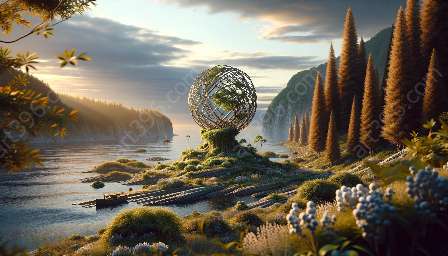Environmental art, a genre that seeks to engage with the natural world, often makes use of multimedia to represent natural landscapes. This practice raises important ethical considerations that impact both the environment and the audience's perception of nature. In this discussion, we explore the implications of multimedia in environmental art and the ethical responsibilities associated with it.
Multimedia in Environmental Art
Environmental art encompasses a wide range of artistic practices that engage with environmental issues and the natural landscape. The use of multimedia, including photography, video, sound art, and digital rendering, has become increasingly common in environmental art due to its ability to capture and represent natural environments in diverse and immersive ways.
This approach allows artists to create thought-provoking and impactful works that address ecological concerns, advocate for conservation, and inspire reflection on the beauty and fragility of nature. By employing multimedia, artists can reach wider audiences and invoke emotional responses, fostering connections between people and the environment.
Ethical Considerations
Despite its potential for meaningful expression, the use of multimedia to represent natural landscapes in environmental art raises ethical considerations that require thoughtful examination. One prominent ethical consideration involves the potential impact of multimedia production on the natural environments being represented.
Photography and videography, for instance, may require invasive techniques or the disturbance of ecosystems to capture compelling imagery, potentially harming the very landscapes artists seek to showcase. Furthermore, the consumption of resources, such as electricity and materials for digital media, raises concerns about the environmental footprint of multimedia production within the context of environmental art.
Another ethical consideration pertains to the accurate and respectful portrayal of natural landscapes. With the technological advancements in digital manipulation and editing, there is a risk of misrepresenting or distorting the true characteristics of natural environments. This raises questions about the authenticity and transparency of multimedia representations in environmental art.
Transparency and Accountability
To address these ethical considerations, artists working with multimedia in environmental art must prioritize transparency and accountability. This involves being mindful of the methods and impact of multimedia production on natural landscapes, striving to minimize ecological harm, and accurately representing the environment without misleading or romanticizing its true state.
Transparency extends to the disclosure of the processes involved in creating multimedia works, including any alterations or enhancements made to the original footage or imagery. By openly communicating the creative process, artists can foster trust and integrity in their representations of natural landscapes.
Engaging the Audience
Furthermore, ethical considerations extend to the audience's perception of multimedia representations in environmental art. Artists should aim to ethically engage viewers by conveying authentic narratives about the natural world, promoting environmental stewardship, and nurturing a deeper understanding of humanity's interconnectedness with nature.
By fostering critical engagement and encouraging dialogue, artists can empower audiences to reflect on their own relationships with the environment and consider the ethical implications of multimedia consumption in the context of environmental art.
Conclusion
Multimedia in environmental art offers immense potential for raising environmental awareness and inspiring transformative experiences. However, ethical considerations are crucial in guiding the responsible and impactful use of multimedia to represent natural landscapes. By upholding transparency, accountability, and a commitment to authentic representation, artists can create multimedia works that contribute to a more ethical and empathetic portrayal of the natural world within the realm of environmental art.

